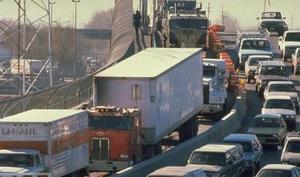Nuclear matters U.S. has no plan to keep nuclear bomb materials from crossing border
In 2006 the George W. Bush administration announced a $1.2 billion project to deploy thousands of scanners for screening vehicles and cargo at U.S. ports to block the importation of radioactive materials that could be used to make a bomb to protect the United States; the scanners — known as the advanced spectroscopic portal (ASP) machines — proved a failure, and in February, following one setback after another, officials abandoned full-scale deployment of the machines; GAO says that the attention and resources invested in the ill-fated ASPs delayed the creation of a “global nuclear detection architecture” to protect the United States

Truck traffic at the Mexican border // Source: life.com
Five years after DHS officials vowed to block the importation of radioactive materials that could be used to make a bomb, they still have not closed security gaps at U.S. borders, according to government auditors and researchers.
The failure to develop a strategic plan has delayed the creation of a “global nuclear detection architecture” that would guide a variety of federal agencies that share responsibility for preventing terrorists from detonating a nuclear bomb in the United States, the Government Accountability Office (GAO), the investigative arm of Congress, has found.
The Washington Post’s Robert O’Harrow Jr. writes that the GAO said that the Domestic Nuclear Detection Office (DNDO), part of DHS, instead of formulating a plan, spent more than $200 million on an ill-fated project to develop and deploy thousands of new high-tech detectors for screening vehicles and cargo at ports. In February, following one setback after another, officials abandoned full-scale deployment of the machines.
“Five years into its existence, it is apparent that the Domestic Nuclear Detection Office needs retooling,” said Senator Joseph I. Lieberman (I-Connecticut), chairman of the Homeland Security and Governmental Affairs Committee, which held a hearing about the office on Wednesday.
DHS spokesman Chris Ortman said the department has taken steps in the past eighteen months “to enhance our radiological and nuclear detection capabilities” and improve cargo screening. He said DHS also is using its own “detection architecture” as a “framework to guide our work with our interagency partners to strengthen our nation’s security against nuclear threats.”
O’Harrow notes that for years, specialists in and out of the government have criticized federal initiatives to prevent terrorists from obtaining nuclear material as uncoordinated and ineffective. The detection office was established by presidential directive in 2005, partly in response to that criticism.
Soon after it was formed, however, the office began focusing heavily on a new kind of detection equipment known as the advanced spectroscopic portal (ASP) machine, or ASP. George W. Bush administration officials announced the $1.2 billion project in 2006, saying it would dramatically improve the government’s ability to screen for radioactive materials. The GAO and other government investigators turned up evidence that the machines did not work as well as billed. They later discovered that they cost more than twice the amount that officials in the detection office had originally told Congress.
While focusing on the ASP machines — which were primarily intended for ports of entry to screen cargo containers
